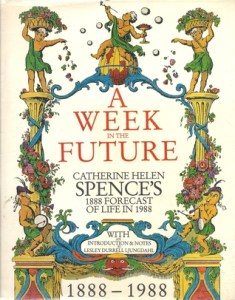
Available online here.
Catherine Helen Spence’s short story A Week in the Future was published serially in the Centennial Magazine between January and July 1889, then later published independently as a book later that year.
I’m not actually accusing her of plagiarism, but in writing this book she borrowed very heavily from her friend Jane Hume Clapperton’s Scientific Meliorism and the Evolution of Happiness, which Spence had reviewed in the Adelaide Observer in 1887. Clapperton’s book itself picked up on George Eliot’s idea of ‘meliorism’ (i.e. that the world tends to improve and that humans can aid its betterment). She remained friends with Clapperton, so obviously this borrowing was not the breach of copyright that we would see it as today.
Basically, the story is that Miss Emily Bethel, a Scottish lady resident in Adelaide who had recently lost her mother (as had, indeed Spence herself when she wrote it) suffered a heart attack and was given a choice of 1-2 years of enforced invalidism or a week in the future instead. She chose to spend one week in the future in England a century hence- i.e. in 1988.
On Monday, she visited an Associated Home, where twenty families lived communally, each having a financial share in the house.
On Tuesday she visited a co-operative farm, travelling by nationalized railways that had replaced the crowded roads, in order to observe the large scale agriculture that has revolutionized food production. There has been global distribution of excess population: Australia including New Zealand, now has a population of 50 million!
On Wednesday she visited a communal nursery, a school and a university. Schooling is between 8 and 14 years of age; men and women attend university in equal proportions.
On Thursday she attended a wedding, where she learns that early marriage is encouraged and that birth control is freely available. Divorce is easily obtainable if there are no children, and after a month, people can remarry. If there are children, the process takes twelve months and the relatives on both sides are chosen as arbiters of guardianship.
On Friday she attended Parliament, where she observed the indirectly elected President (i.e. elected by Parliament), the popularly elected House of Commons and House of Lords and the absence of royalty.
On Saturday she indulged in Literature and Arts by visiting the enlarged National Gallery and attending the opera.
On Sunday she attended a church. There was still worship, but a change in the idea of the Being they worshipped. No ‘miserable sinners’, no hell, no destruction. And Sundays were a day of entertainment and rest, just like Saturday.
At the end of all this, Miss Bethel departed, breathing the prayer “Now, Lord, let thy servant depart in peace, now that I have seen the salvation wrought by the brotherhood of the families of the earth.”
As you can see, the story is very much a vehicle by which Spence expounds on her views of the way society should run, largely influenced by her Unitarian faith. Like Unitarians in England, she favoured co-operative housing, she believed in girls’ education, and embraced a religion that did not grind its adherents under the burden of original sin.
A Week in the Future is in effect a political tract, wrapped in a story. Still, given that for us 1988 has been and gone, it’s interesting seeing the aspects she highlighted, which in many cases still have yet to come to pass.
Bill Holloway at The Australian Legend site wrote a fuller review of the book that’s well worth reading.

This review has been posted on the Australian Women Writers Challenge page.

Thanks for finding the link, I’m certainly going to read this because it sounds fascinating.
Thanks again for a terrific talk on Sunday!
Thanks for the mention. I didn’t see that it had been published after the initial serialization. Do you have the book? It’s well worth owning, and not just for that glorious cover. I found my copy in the second hand bookshop on the river at Warrandyte, which I always love to visit.
Pingback: March 2018 Round-up: Classics and Literary – Australian Women Writers Challenge Blog
Pingback: Australian Women Writers Challenge 2018 completed | The Resident Judge of Port Phillip
Pingback: Clara Morison, Catherine Helen Spence | The Australian Legend